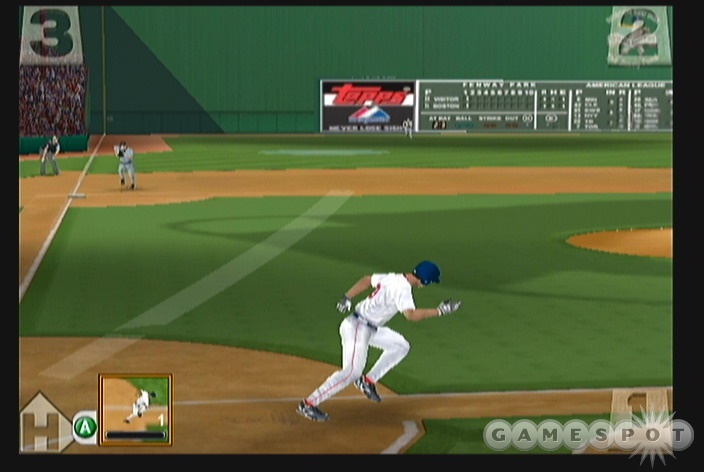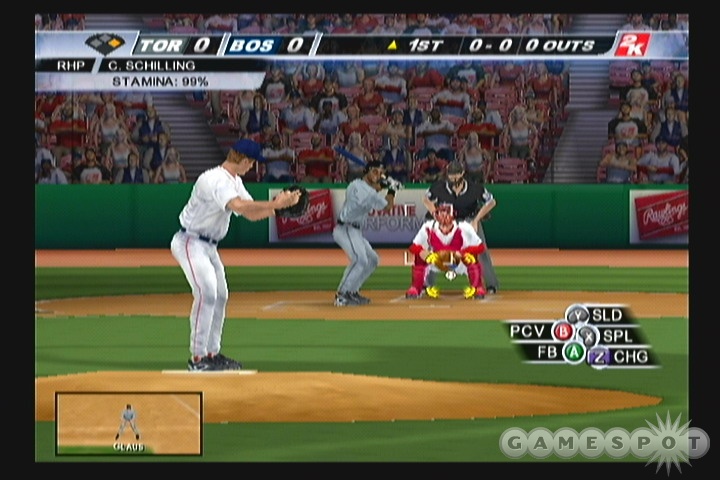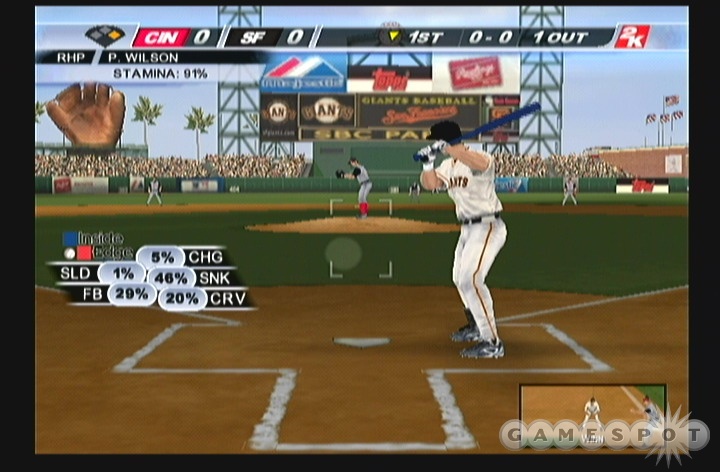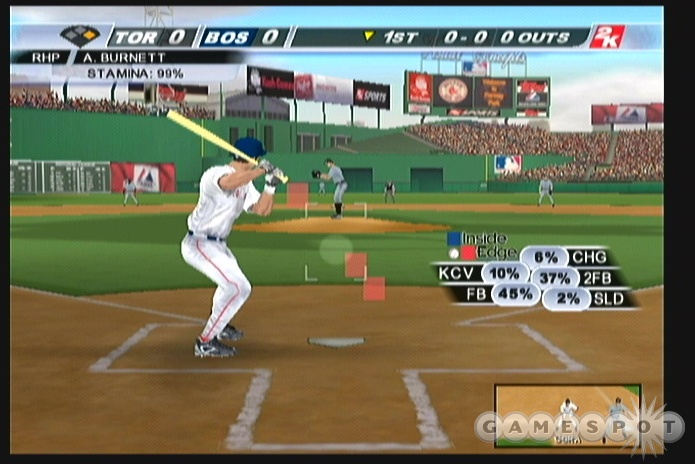At last, the wait is over. The GameCube version of Major League Baseball 2K6 is finally on store shelves, approximately two months after the Xbox, PlayStation 2, PlayStation Portable, and Xbox 360 versions shipped. The developers wisely took advantage of the extra development time to fix all of the bugs that plagued the other versions, transforming a formerly haphazard game into a solid baseball simulation. For some reason, however, they hardly did anything to spice up the game's sleepy atmosphere. They also didn't bother to update the team rosters, which is a no-no for a version that doesn't have any online features. Of course, at the end of the day what matters most is that the game portrays the nuts and bolts of the sport really well. It's just a shame it doesn't do so in an exciting or up-to-date fashion.

From a technical standpoint, the graphics aren't all that bad. Player faces are accurate and their uniforms look sufficiently clothlike. Play animations and the transitions between them are fluid in the GameCube game, which marks a significant improvement over the jerky animations found in other versions. There are also just more plays to see, in general, in this version of the game. Spectators look like actual people, and they gesture independently of one another. Stadium dimensions and architecture are spot on, for the most part. Texture quality is so good that you can actually read all of the stadium advertisements and scoreboards, which update throughout the course of a game. Overall, the graphics are crisp and pleasing to the eye.
Unfortunately, while the graphics are decent in the technical sense, the atmosphere they serve to convey is utterly lifeless. After a play is made, the players just stand there. Other baseball video games at least attempt to make the players seem lifelike, by having them loiter about or toss the ball around. Broadcast-style cutaways are limited to home runs, double plays, and the occasional strikeout replay. Incredibly, there are actually fewer broadcast-style cutaways in the GameCube game than there were in any of the other console versions of MLB 2K6. There aren't any batter walk-ups or post-strikeout reaction shots, for example. The game doesn't even show a score recap between innings. After the last out of an inning, the sides just instantly change without any sort of visual segue. Compared to other baseball video games, the presentation here is absolutely conservative.
The audio portion fares better. In general, there's a satisfying range of sound effects, stadium announcements, and player-specific crowd catcalls. In exciting situations, the volume of the crowd turns louder and stadium speaker cues become more frequent. Compared to other baseball video games, the stadium music and announcements in MLB 2K6 aren't as loud or as frequent, but they get the job done. ESPN's Jon Miller and Joe Morgan, arguably the best commentator team in baseball today, have the in-game play-calling duties. They keep pace with the action fairly well and have a lot to say, especially if you put down the controller and let them talk. Even though their calls don't exude much in the way of emotion, their conversational rapport is still eerily lifelike.

While its portrayal of the sport is sleep-inducing, MLB 2K6 does manage to provide a good selection of play modes and a deep gameplay experience. The 10 different included play modes are quick game, season, franchise, GM career, World Baseball Classic, playoffs, home run derby, home run derby career, manager showdown, and situation. All of the online modes were stripped out of the GameCube version, but you can still play against your buddies on the same console. A number of built-in player- and roster-editing utilities let you create and trade players, which is a good thing, because the default rosters are accurate only as of opening day. Aspiring general managers will enjoy the GM and franchise modes. They don't let you set concession prices or sell advertising, but they do implement player morale and fatigue as day-to-day variables, which you can subsequently manage by shuffling lineups and adjusting how much time off your players get. In the majority of play modes, you can choose to play the game, spectate, or manage from the sidelines. Stats are automatically tracked in more than 100 individual categories and subcategories. Various settings menus let you tweak the difficulty, control configurations, and multiple tuning sliders to your liking.
On the field, you can literally control every aspect of a ball game. Managerial functions let you make substitutions, warm up pitchers, and visit the mound whenever you like. If the umpire makes a close play or a batter gets beaned, sometimes the game will prompt you to argue the call or charge the mound. Doing so, however, may result in your manager or player being ejected. The fielding and baserunning interfaces are mostly identical to those in other games. Leadoffs and stolen-base attempts can be queued up before the pitch, and you can command a player to make a diving catch or slide into a base just by pulling on the C stick. As in previous years, MLB 2K6 is the only baseball game that lets you compel runners and fielders to kick in an extra burst of speed by rapidly tapping the relevant buttons. The risk of injury or fatigue is higher when kicking in the afterburners, though.
Hitting and pitching are intricate but fairly easy to learn. The default hitting interface lets you swing the bat with the C stick. You pull back on the stick to take a step and then let go for a contact swing or push upward for a power swing. At the same time, you can target your swing to specific spots in the strike zone by positioning a circular batter's-eye indicator with the left analog stick. Taken together, you have to pick your spot and time your swings in MLB 2K6, just like the pros do. Pitching employs a new take on the meter-style pitching that's all the rage in baseball games these days. You select pitches with the buttons and aim using the left analog stick, just like you've done in every other baseball game produced in the last decade or so; but now, the circular targeting cursor quickly grows and shrinks after you press the button. This indicates how much power or break you've built into the pitch. Letting up on the button locks in the effectiveness and causes the circle to quickly collapse into a crosshair. You then have to tap the button one more time to lock in the accuracy. The smaller the circle is, the more accurate the pitch will be. In practice, it's a highly intuitive system that boils the complex art of pitching down to a couple of quick button presses.

Another intriguing aspect of the pitching interface is that it's actually possible to specify where the catcher sets up for each pitch. Pulling the C stick will position the catcher's glove over any of eight spots around the strike zone. This lets you psych out players by setting up outside for inside pitches and inside for outside pitches. It's also the key to the game's optional payoff-pitch mechanism. In a real baseball game, a pitch made on a two-strike count is called the payoff pitch, because the pitcher's confidence can be shaken or strengthened based on whether the next pitch is a ball, a hit, or a strike. MLB 2K6 simulates this when you choose to position the catcher on a two-strike count. If your pitch lands in the glove without causing the catcher to move, you'll add a couple of points to your pitcher's effectiveness rating. If the catcher has to move to catch the ball, you'll lose a couple of points. Perhaps the implementation is a little bizarre, but the ability to adjust the catcher's positioning is still a welcome addition.
Unique to the batter-versus-pitcher confrontation in MLB 2K6 is the game's Inside Edge system. Besides incorporating scouting reports and statistical data into player strengths and CPU behavior, the Inside Edge system will actually make hitting and pitching suggestions to you on a pitch-by-pitch basis during the game. When you're on the mound, the game will suggest the most effective pitch and location based upon the hitter's past performance in that particular count. When you're up to bat, the game will show you how likely a pitcher is to throw each of his pitches, as well as display the three most likely spots where the next pitch will be located. What makes Inside Edge so captivating is that it makes scouting data an integral part of gameplay, but still challenges you to factor your own hunches and baseball knowledge into each situation.
Generally, MLB 2K6 does a good job of portraying what tends to happen during a real-life professional baseball game. The CPU plays a smart game, is relatively aggressive on the bases, and makes substitutions when they're appropriate. Overall, the ratio of ground balls to liners and fly balls is right on the money. When you swing too early or too late at pitches, foul balls and weak pop-ups are more likely to result than clean hits. Nitpickers will notice that hits are somewhat easy to get on the default pro difficulty setting, but that's easily fixed by upticking to a higher setting or adjusting any of the 40-plus tuning sliders. Pitchers get rattled when there are men on base with no outs, or when a fast runner is on first, which causes the pitching cursor to bob and weave. Inexperienced fielders also tend to bobble the ball or make offline throws more often than veteran players do.

One pleasant surprise regarding the GameCube version of MLB 2K6 is that it doesn't seem to suffer from any of the glitches that the other versions of the game do. In the PS2, Xbox, and Xbox 360 versions, base runners will sometimes overshoot the bag, and fielders will sometimes run over the ball without picking it up. Once in a while in those versions, when you press the analog stick to have a fielder run in one direction, he'll run in the exact opposite direction! These bugs don't happen in the GameCube version. It's nice to see that Kush Games used the extra two months of development time to iron out these kinks. The game is much more enjoyable when you're not constantly worrying whether your players will go stump-dumb at inopportune moments.
If you're a baseball fan and the only game console you own is Nintendo's GameCube, then by all means, go out and grab Major League Baseball 2K6. Its portrayal of the sport may not be exciting, but the underlying gameplay is deep and satisfying.